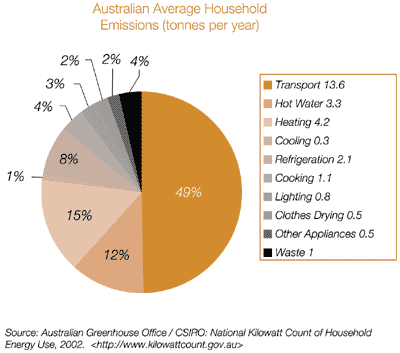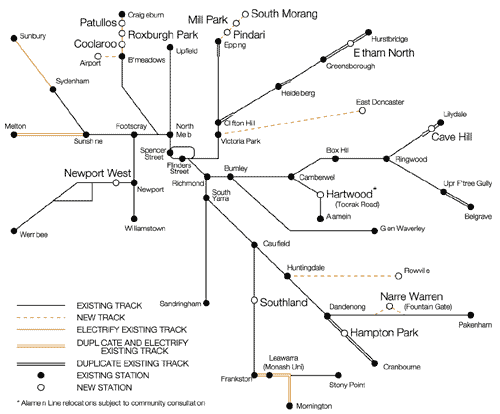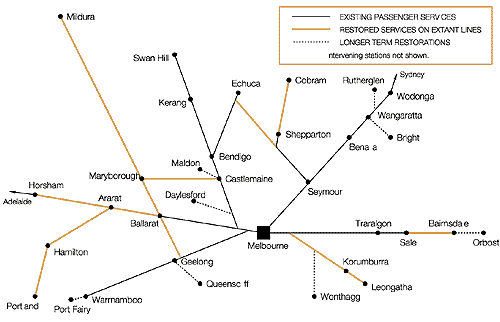“It’s Time To Move” is now available for free download. Originally published in 2002, the book forms the basis of the PTUA’s policies, and explains what needs to be done to make Melbourne and Victoria’s public transport world-class, to reduce car dependency, improve economic efficiency, help the natural environment, and make our state more liveable.
Summary
This summary is available in PDF format for printing (PDF, 556 Kb)
The Importance of Public Transport
All around Melbourne, people are concerned about the quality of public transport. Public authorities, from local councils to Federal government agencies, pay lip service to the idea of reducing car dependence and encouraging alternatives such as public transport, walking and cycling. Yet the majority of Melburnians do virtually all of their travel by car and show no signs of changing. Why should we bother making the effort?
The transport and accessibility topic area was the most popular during Round 2 of consultation and almost 33 per cent of forum participants were involved in discussions. Strong support was recorded for initiatives to reduce or improve car usage, and increase the service levels of public transport. Initiatives to encourage walking and cycling to work also drew general support from participants. The participants in support of more roads and freeways were in the minority.
-Metropolitan Strategy Information Bulletin,
November 2001
A Triple Bottom Line Analysis
ECONOMY
Both public transport and roads consume scarce resources: money, land, and fuel to operate vehicles. In its resource use public transport has what economists call returns to scale: the more users, the greater the economic benefit. Road traffic, on the other hand, displays diminishing returns to scale. This is because roads quickly fill up with traffic, and once congestion sets in, each additional vehicle slows everyone down.
Melbourne’s public transport and road systems will both remain heavily subsidised as long as car use continues to spiral out of control, and little is done to attract people to public transport.
Efficient transport systems around the world rely on public transport providing a genuine alternative to car travel, so that public transport is used for 25 to 50 percent of all travel and cost recovery is high for both the public transport and road systems.
ENVIRONMENT
Pollution and noise from cars is injurious to public health, and freeway-building has only made things worse. The explosion in private car trips resulting from road-friendly transport policies means that transport now accounts for more adverse health impacts than ever before, and half of all greenhouse emissions from Australian households are transport-related.
Shifting car trips to public transport reduces pollution and noise, helps conserve open space in the long term, supports other environmentally friendly modes like walking and cycling, and is vital to our efforts to avert climate change.
SOCIETY
Neighbourhood activists and researchers from the 1950s onwards have documented the alienating effect car-dependent ‘mobility’ has on local communities. It is now known that when there is less traffic on the street, people actually build richer social networks and have more friends and acquaintances.
Public transport is crucial also to providing independent mobility for children. This kind of independence is vital to our psychological development, but is undermined by car dependence that results in children being driven everywhere by parents.

Making Public Transport Work For Everyone
1. POLICY, MANAGEMENT AND OWNERSHIP
Making the Change: Better Transport Planning
In Melbourne, the current structure of the transport planning bureaucracy institutionalises a powerful road lobby at the highest levels of policy-making. In lobbying politicians for new freeways, Department of Infrastructure bureaucrats are assisted by the autonomous agency VicRoads, and also by the engineering departments of Victoria’s municipal councils, which with very few exceptions are dominated by the road engineering mindset.
While VicRoads has both a plan and a successful lobbying strategy, nothing of the sort exists for public transport. Privatisation of train and tram operations in 1999 has returned us to the Balkanised situation of most of the twentieth century, with operators fighting over a dwindling market share and ignoring the real competition, the private car. In most other cities of the world, transport planning is run by transport planners and local communities rather than by those with a vested interest in more roads. Even Perth, one of the lowest-density cities in Australia, has seen fit to cancel its freeway projects and spend money on public transport instead.
Achieving ‘world’s best practice’ in transport planning means overhauling the present Department of Infrastructure to emphasise the need to plan before spending money on big projects. Instead of a separate agency presenting one freeway plan after another to the government as a fait accompli, there should be one group of planners with a single budget and a brief to pursue the best transport projects according to transparent criteria.
Coordination vs. Privatisation: Better Transport Management
Historically, the ‘free-market’ approach to transport management only wound up driving away passengers, leaving those who remained with poorer services that required ever-greater subsidies. Today’s privatised arrangements, that encourage operators to compete with one another for passengers rather than coordinate their services, are unlikely to deliver anything better.
Privatisation allows government planners to offload responsibility for service provision onto individual train, tram and bus operators who have no incentive to coordinate their timetables. Operators are instead rewarded for undermining the viability of other public transport modes by running parallel services.
To unravel this mess doesn’t require resuming public ownership of trains, trams and buses. However, it will require resuming public control, which is a different thing altogether. What will be needed is a Transport Authority with the power to set timetables for all transport modes, whether publicly or privately operated. The model for this is the Verkehsverbund or ‘Transport or ‘Transport Community’ found in many cities in Germany and central Europe. These are regional transport companies managed by government, municipal and community representatives. They have responsibility for coordinating fares, timetables and funding for all public transport services in their region.
For this to work it will be necessary to convert the current franchise agreements to fee-for-service contracts. A proactive government should have little difficulty negotiating this.
2. SERVICES AND INFRASTRUCTURE
Minimising total journey time
The most important factor making public transport attractive relative to car travel is the total journey time. There is no law of nature that says public transport has to be twice as slow as driving; it’s just that in Melbourne there has never been any concerted effort to make it more responsive.
There are many sides to the problem of reducing journey times, and so a package of solutions is required. However, each part of the solution is quite simple in itself. The most important components are high service frequency, traffic priority and timetable coordination.
Service Coverage
Melbourne is fortunate to have one of the most comprehensive public transport networks for a city of its size anywhere in the world. However, coverage is far from equal. A minority benefit from seven-day services; the majority get inadequate services during the day and none at all in the evenings or on Sundays.
There should be no haves and have-nots in public transport. All that is required to extend decent services to the entire urban area is a small number of network extensions, and an overhaul of suburban bus routes and hours of operation.
A System Serving Passengers
For too long, transport operators in Melbourne have displayed a hostile ‘Basil Fawlty’ attitude toward their passengers.
The perception that services are run for the convenience of operators, not passengers, has not changed with privatisation. Currently, it is reflected in the dysfunctional Metcard ticketing system the ongoing refusal to even contemplate returning staff to trams and stations, and the lack of adequate seating on new vehicles.
Returning tram conductors and station Returning tram conductors and station staff would incur virtually no net cost staff would incur virtually no net cost to the public, and would remedy the most annoying aspects of the ticketing system.
Reconnecting Victoria
The same principles that apply to public transport in Melbourne also apply throughout country Victoria. The settled parts of Victoria (excluding only the Mallee and the High Country) are comparable with Sweden in their population density, and can be expected to support similar levels of public transport service.
We recommend that the country train and bus network be recast on a ‘pulse network’ model featuring seven-day services, comprehensive coverage, timetable coordination at hourly intervals, and bus networks within regional cities. and bus networks within regional cities.
Dealing with the Urban Myths
Institutional opposition to public transport is reinforced by the propaganda of the road lobby, which portrays public transport as something that is nice in principle but flawed in practice. Even well-meaning people can be induced to believe that big public transport improvements are too costly, or won’t attract enough passengers, or won’t work for some other reason.
Is Melbourne too spread-out?
It is fashionable to argue that public transport can only be viable in high-density, compact cities with lots of apartment blocks. While rail systems have a certain ‘natural advantage’ in such cities, public transport will also work in medium-density cities like Melbourne if it is sufficiently attractive to passengers. 100 years ago, Melbourne was the lowest-density city in the world not in spite of, but because it had extensive public transport that made it easy to travel to the suburbs. Melbourne’s urban density has not markedly declined since then, nor has it declined relative to other cities with wellused public transport.
Do we have to give up cars?
The elimination of the car is both unlikely and unnecessary. All that is needed to relieve Melbourne’s traffic problems is to shift a small, but significant, minority of car trips-about one journey in five-from the car to walking, cycling or public transport.
An extreme version of the car-is-inevitable argument claims that once people own cars, they will use them for all their travel, regardless of the alternatives. This is an insulting attitude: it assumes most people are stupid. High car ownership does not necessarily mean high car use. Many overseas cities renowned for their successful public transport have car ownership rates just as high-or higher-than Melbourne.
Won’t we just have to pour more money into public transport subsidies?
Our economic discussion provides the key to making better public transport pay its way. Public transport competes with the private car for its customers, and its success in attracting customers, not some innate superiority of private cars, determines its financial viability. The key is better service, leading to greatly increased patronage and cost recovery across the entire system.
Metropolitan Train Network: PTUA proposals
 Country Train Network: PTUA proposals
Country Train Network: PTUA proposals

(See our full document for full details of projects, plus proposals for tram and bus networks, road projects and tax reform.)
Comparative costing of road and public transport proposals
| Our proposal | Cost ($million) | Road lobby proposal | Cost ($million) | ||
| Rowville train line | 120 | 1 / yr | Scoresby / Mitcham Freeway | 1800 | 18 / yr |
| East Doncaster train line | 350 | 2 / yr | Eastern Freeway thru Royal Pk | 600 | 6 / yr |
| Airport train extension | 50 | 1 / yr | Tulla / Calder Fwy intersection | 250 | 2 / yr |
| Other train extensions | 488 | 2 / yr | Merri Creek Freeway | 400 | 4 / yr |
| Bus network improvements | 30 / yr | Second West Gate Bridge | 1000 | 10 / yr | |
| Tram gap-filling programme | 215 | 2 / yr | Eastern Ring Road completion | 800 | 8 / yr |
| Level crossing elimination | 500 | Victoria Pde flyovers | 50 | ||
| Re-staffing the system | 25 / yr | Dingley Freeway | 300 | 3 / yr | |
| Late night services | 5 / yr | Hallam Bypass | 165 | 2 / yr | |
| Revitalised country rail | 500 | 50 / yr | Geelong Road upgrade | 270 | 3 / yr |
| Inter-regional bus network | 40 / yr | Calder Highway upgrade | 500 | 5 / yr | |
| Geelong train improvements | 5 | 1 / yr | Geelong East Ring Road | 1000 | 10 / yr |
| Geelong bus network | 4 / yr | Geelong West Ring Road | 380 | 4 / yr | |
| Remove GST on fares (Vic) | 40 / yr | Subsidy to company cars (Vic) | 150 / yr | ||
| Total | 2228 | 203 / yr | Total | 7515 | 225 / yr |
General Recommendations
1. Service Frequencies
Improve service frequencies on all urban train, tram and bus services to every 10 minutes or better between 5am and 10pm, and every 15 minutes between 10pm and 2am, seven days a week. Retain existing service frequencies when better than this.
In country Victoria, adopt a basic frequency of one train per hour between 6am and midnight seven days a week; higher for Geelong, Ballarat, Bendigo and Gippsland services and lower for services to remote towns such as Mildura.
2. Night Services
Implement 24-hour, 7-day public transport in Melbourne with a system of night buses and trams between 2am and 5am. Upgrade the Nightrider buses to bidirectional half-hourly services, accepting Metcards in line with Recommendation 8, and mirroring all current and proposed rail corridors, with appropriate deviations to serve suburbs such as Bundoora.
3. Express Running
Improve travel times for urban train services through express running patterns that are consistent for any given route, apply at all times rather than just in peak hour, and ensure that every station receives at least one stopping service every ten minutes. If necessary, express trains can be alternated with stopping trains that service intermediate stations on the same line.
4. Train Speeds
Maintain all passenger rail track in Victoria to speed standards allowing consistent 80kph running (or better) in metropolitan Melbourne and 160kph running in the remainder of Victoria.
5. Tram and Bus Priority
Implement effective priority for trams and buses over other traffic, with the aim of eliminating all unnecessary delays to services, through:
- greater use of barriers to separate trams from cars;
- interruption of traffic signals for trams at all intersections;
- shortening of signal cycles on major intersections; and
- enforcing the ‘fairway’ system.
These should be implemented in consultation with all relevant transport, police, municipal and community organisations.
6. Bus Route Restructure
Reconfigure metropolitan bus routes to be direct and avoid complicated detours. Ensure that routes follow the arterial road grid as much as possible, and provide convenient interchange with trains at all stations en route.
Design bus stops at major intersections to make transfers between buses as convenient as possible. The network grid should be sufficiently fine to ensure that the vast majority of locations are within walking distance of a bus stop. Attempts to connect all origins and destinations with a single route should be avoided.
7. Staff and Ticketing
Return full-time staff to all railway stations from first to last train, and conductors to all tram and train services, except those with low patronage and no security problems. Have staff sell tickets alongside ticket machines at stations, and charge all staff with a duty to assist passengers. Remove ticket machines from all trams that have conductors, and remove the requirement to revalidate already valid tickets. Use the police as a targeted emergency backup for front-line staff, and ensure that staff have a clear view of platforms, vehicles and waiting areas.
8. Fares
Retain and extend the multimodal fare system with better integration of metropolitan and country fares and the abolition of all singlemode tickets. Have the multimodal fare system cover all public transport services, including Skybus and Nightrider. Set fares at a level competitive with private car travel. Provide periodical ticket holders with attractive discounts and free family travel on weekends and public holidays.
9. Coordination of Services
Reestablish public control over public transport services in Melbourne through a Transport Authority (TA). Establish a governing structure comprising State Government, local councils, industry and user representation. Charge the TA with responsibility for administering the fare system, collecting and distributing revenue, and setting routes and timetables for all public transport in Melbourne. Renegotiate existing contracts between private operators and the State Government so that private operators act as contractors to the TA, and are paid for the services they provide on a ‘cost plus margin’ basis.
10. Transport Infrastructure Planning
Vest all planning powers for road and public transport infrastructure in a newly constituted Department of Planning and Infrastructure, following the example of Western Australia. Appoint experienced planners, rather than road engineers, to head up the new department. Abolish VicRoads as a separate entity and absorb its functions into the new structure. Give the department a single budget, to spend in accordance with transparent economic, social and environmental criteria, with no artificial distinctions drawn between ‘road funding’ and ‘public transport funding’. Involve the community in the evaluation of proposals, and subject planning decisions to independent review.
In order to guarantee that people have a genuine choice to use public transport, declare a moratorium on new urban freeways until public transport has been improved to useable levels, as outlined in Recommendations 1 through 8.

